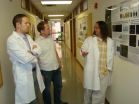(Press-News.org) New York, NY—March 18, 2012—As nanotechnology becomes ever more ubiquitous, researchers are using it to make medical diagnostics smaller, faster, and cheaper, in order to better diagnose diseases, learn more about inherited traits, and more. But as sensors get smaller, measuring them becomes more difficult—there is always a tradeoff between how long any measurement takes to make and how precise it is. And when a signal is very weak, the tradeoff is especially big.
A team of researchers at Columbia Engineering, led by Electrical Engineering Professor Ken Shepard, together with colleagues at the University of Pennsylvania, has figured out a way to measure nanopores—tiny holes in a thin membrane that can detect single biological molecules such as DNA and proteins—with less error than can be achieved with commercial instruments. They have miniaturized the measurement by designing a custom integrated circuit using commercial semiconductor technology, building the nanopore measurement around the new amplifier chip. Their research will be published in the Advance Online Publication on Nature Methods's website on 18 March at 1400 (2pm) US Eastern time/ 1800 London time.
Nanopores are exciting scientists because they may lead to extremely low-cost and fast DNA sequencing. But the signals from nanopores are very weak, so it is critically important to measure them as cleanly as possible.
"We put a tiny amplifier chip directly into the liquid chamber next to the nanopore, and the signals are so clean that we can see single molecules passing through the pore in only one microsecond," says Jacob Rosenstein, a Ph.D. candidate in electrical engineering at Columbia Engineering and lead author of the paper. "Previously, scientists could only see molecules that stay in the pore for more than 10 microseconds."
Many single-molecule measurements are currently made using optical techniques, which use fluorescent molecules that emit photons at a particular wavelength. But, while fluorescence is very powerful, its major limitation is that each molecule usually produces only a few thousand photons per second. "This means you can't see anything that happens faster than a few milliseconds, because any image you could take would be too dim," explains Shepard, who is Rosenstein's advisor. "On the other hand, if you can use techniques that measure electrons or ions, you can get billions of signals per second. The problem is that for electronic measurements there is no equivalent to a fluorescent wavelength filter, so even though the signal comes through, it is often buried in background noise."
Shepard's group has been interested in single-molecule measurements for several years looking at a variety of novel transduction platforms. They began working with nanopore sensors after Marija Drndic, a professor of physics at the University of Pennsylvania, gave a seminar at Columbia Engineering in 2009. "We saw that nearly everybody else measures nanopores using classical electrophysiology amplifiers, which are mostly optimized for slower measurements," notes Shepard. "So we designed our own integrated circuit instead."
Rosenstein designed the new electronics and did much of the lab work. Drndic's group at the University of Pennsylvania fabricated the nanopores that the team then measured in their new system.
"While most groups are trying to slow down DNA, our approach is to build faster electronics," says Drndic. "We combined the most sensitive electronics with the most sensitive solid-state nanopores."
"It's very exciting to be able to make purely electronic measurements of single molecules," says Rosenstein. "The setup for nanopore measurements is very simple and portable. It doesn't require a complicated microscope or high powered instruments; it just requires attention to detail. You can easily imagine nanopore technology having a major impact on DNA sequencing and other medical applications within the next few years."
Shepard's group is continuing to improve these techniques. "With a next-generation design," he says, "we may be able to get a further 10X improvement, and measure things that last only 100 nanoseconds. Our lab is also working with other electronic single-molecule techniques based on carbon nanotube transistors, which can leverage similar electronic circuits. This is an exciting time!"
INFORMATION:
This research has been funded by the National Institutes of Health, the Semiconductor Research Corporation, and the Office of Naval Research.
Columbia Engineering
Columbia University's Fu Foundation School of Engineering and Applied Science, founded in 1864, offers programs in nine departments to both undergraduate and graduate students. With facilities specifically designed and equipped to meet the laboratory and research needs of faculty and students, Columbia Engineering is home to NSF-NIH funded centers in genomic science, molecular nanostructures, materials science, and energy, as well as one of the world's leading programs in financial engineering. These interdisciplinary centers are leading the way in their respective fields while individual groups of engineers and scientists collaborate to solve some of modern society's more difficult challenges. http://www.engineering.columbia.edu/
Columbia Engineering and Penn researchers increase speed of single-molecule measurements
New integrated circuit design could lead to cheaper, faster DNA sequencing
2012-03-19
ELSE PRESS RELEASES FROM THIS DATE:
A surprising new kind of proton transfer
2012-03-19
When a proton – the bare nucleus of a hydrogen atom – transfers from one molecule to another, or moves within a molecule, the result is a hydrogen bond, in which the proton and another atom like nitrogen or oxygen share electrons. Conventional wisdom has it that proton transfers can only happen using hydrogen bonds as conduits, "proton wires" of hydrogen-bonded networks that can connect and reconnect to alter molecular properties.
Hydrogen bonds are found everywhere in chemistry and biology and are critical in DNA and RNA, where they bond the base pairs that encode genes ...
Genetic variation in East Asians found to explain resistance to cancer drugs
2012-03-19
DURHAM, N.C., AND SINGAPORE – A multi-national research team led by scientists at Duke-NUS Graduate Medical School has identified the reason why some patients fail to respond to some of the most successful cancer drugs.
Tyrosine kinase inhibitor drugs (TKIs) work effectively in most patients to fight certain blood cell cancers, such as chronic myelogenous leukemia (CML), and non-small-cell lung cancers (NSCLC) with mutations in the EGFR gene.
These precisely targeted drugs shut down molecular pathways that keep these cancers flourishing and include TKIs for treating ...
Exotic materials will change optics, Duke researchers say
2012-03-19
DURHAM, N.C. -- Duke University engineers believe that continued advances in creating ever-more exotic and sophisticated man-made materials will greatly improve their ability to control light at will.
The burgeoning use of metamaterials in the field of optics does not rely on the limited set of materials found in nature, but rather man-made constructs that can be designed to control light's many properties. This control is gained by use of metamaterials, which are not so much single substances but entire man-made structures that can be engineered to exhibit properties ...
Special Safety Issues Facing Older Drivers and Pedestrians
2012-03-19
As we most of us already know, aging usually means we'll experience more problems with our hearing, vision and motor skills. In order to grow older safely, we must first recognize our vulnerabilities. Once we do this, we can adapt our behavior in order to create a safer environment for ourselves and everyone else.
The following statistics shed light on the special safety issues facing seniors both behind the wheel and when walking around as pedestrians.
Safety Issues for Senior Drivers/Pedestrians
(Note: In 2009, approximately 40 million Americans were age 65 and ...
Bone marrow transplant arrests symptoms in model of Rett syndrome
2012-03-19
A paper published online today in Nature describes the results of using bone marrow transplant (BMT) to replace faulty immune system cells in models of Rett Syndrome. The procedure arrested many severe symptoms of the childhood disorder, including abnormal breathing and movement, and significantly extended the lifespan of Rett mouse models. Exploring the function of microglia deficient in methyl-CpG binding protein 2 (Mecp2), the protein encoded by the "Rett gene," principal investigator Jonathan Kipnis, Ph.D. and his team at the University of Virginia School of Medicine ...
The Viking journey of mice and men
2012-03-19
House mice (Mus musculus) happily live wherever there are humans. When populations of humans migrate the mice often travel with them. New research published in BioMed Central's open access journal BMC Evolutionary Biology has used evolutionary techniques on modern day and ancestral mouse mitochondrial DNA to show that the timeline of mouse colonization matches that of Viking invasion.
During the Viking age (late 8th to mid 10th century) Vikings from Norway established colonies across Scotland, the Scottish islands, Ireland, and Isle of Man. They also explored the north ...
The Japanese traditional therapy, honokiol, blocks key protein in inflammatory brain damage
2012-03-19
Microglia are the first line defence of the brain and are constantly looking for infections to fight off. Overactive microglia can cause uncontrolled inflammation within the brain, which can in turn lead to neuronal damage. New research published in BioMed Central's open access journal Journal of Neuroinflammation shows that, honokiol (HNK) is able to down-regulate the production of pro-inflammatory cytokines and inflammatory enzymes in activated microglia via Klf4, a protein known to regulate DNA.
Scientists from the National Brain Research Centre, Manesar, India, used ...
Hazy shades of life on early Earth
2012-03-19
A 'see-sawing' atmosphere over 2.5 billion years ago preceded the oxygenation of our planet and the development of complex life on Earth, a new study has shown.
Research, led by experts at Newcastle University, UK, and published today in the journal Nature Geoscience, reveals that the Earth's early atmosphere periodically flipped from a hydrocarbon-free state into a hydrocarbon-rich state similar to that of Saturn's moon, Titan.
This switch between "organic haze" and a "haze-free" environment was the result of intense microbial activity and would have had a profound effect ...
Marine Protected Areas are keeping turtles safe
2012-03-19
Marine Protected Areas (MPAs) are providing sea turtles with an ideal habitat for foraging and may be keeping them safe from the threats of fishing. A study by an international team of scientists led by the University of Exeter, published today (Thursday 15 March), shows that 35 per cent of the world's green turtles are found within MPAs. This is much higher that would be expected as only a small proportion of shallow oceans are designated as MPAs.
MPAs are areas of ocean in which marine activities such as fishing are restricted. Regulated by governments and NGOs, in ...
Personal Electronics Linked to Rise in Pedestrian Accidents
2012-03-19
A study recently released by the University of Maryland found that pedestrian fatalities are on the rise due to distractions from headphone use. The majority of incidents were found among men younger than 30 who lived in urban areas.
The issue is that headphones playing music directly in pedestrians' ears may hinder their ability to hear oncoming car horns, revving engines, beeping crosswalk lights and even blaring train whistles. The study was conceived after a train killed a teenager wearing headphones while crossing railroad tracks. The teenager's music had drowned ...
LAST 30 PRESS RELEASES:
New fully digital design paves the way for scalable probabilistic computing
Membrane electrode assembly design for high-efficiency anion exchange membrane water electrolysis
U.S. debt ceiling disputes show measurable impact on global crude oil markets
Climate extremes triggered rare coral disease and mass mortality on the Great Barrier Reef
Direct observation reveals “two-in-one” roles of plasma turbulence
Humans rank between meerkats and beavers in monogamy ‘league table’
US fossil reveals early mass-burial event and ancient microbial attack
Sedative choice could improve outcomes for breathing tube patients
New superconducting thin film for quantum computer chips
Simulations reveal protein "dynamin" constricts cell membranes by loosening its grip
Nearly 1 in 5 UK emergency department patients cared for in corridors/waiting rooms
Heavy energy drink intake may pose serious stroke risk, doctors warn
Violence against women and children among top health threats: New global study reveals disease burden far larger than previously estimated
Predicting who is at risk of developing type 1 diabetes, as new drugs now available
New gene-mapping method unlocks hidden drivers of cancer
Ocean current and seabed shape influence warm water circulation under ice shelves
Call to increase funding for ‘invisible’ Deaf victim-survivors of domestic abuse
University of Maryland School of Medicine names distinguished scientist and academic leader Gerald M. Wilson, PhD, as Chair of the Department of Biochemistry and Molecular Biology
Receptors in mammary glands make livestock and humans inviting hosts for avian flu
Icy hot plasmas
Treating adults with autism: Maryland Clinical Center offers national blueprint for care after pediatric transition
University of Phoenix College of Doctoral Studies releases white paper on reclaiming control to build workforce resilience
NCCN Summit seeks to improve care for veterans and first responders with cancer from line-of-duty exposure
ERC Consolidator Grant for soft robotics researcher
Dual-action arts and wellbeing program transforms dementia care
The global plastic waste trade contributes to coastal litter in importing countries, study shows
UT Dallas partners with Tech Mahindra on AI innovation
Blinking less could signal the brain is working harder to listen, Concordia study shows
Male bonobos track females’ reproductive cycle to maximize mating success
New report outlines science priorities for human Mars exploration
[Press-News.org] Columbia Engineering and Penn researchers increase speed of single-molecule measurementsNew integrated circuit design could lead to cheaper, faster DNA sequencing




